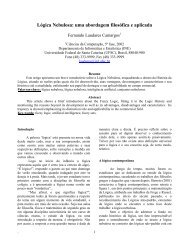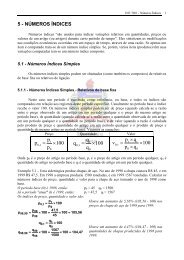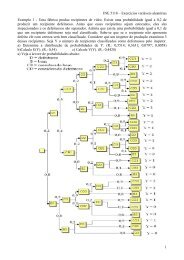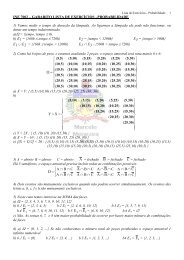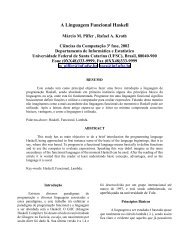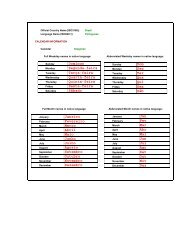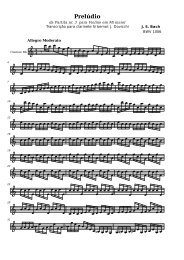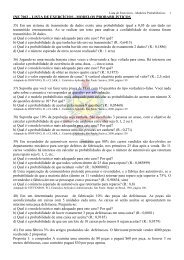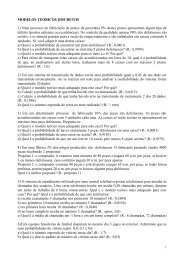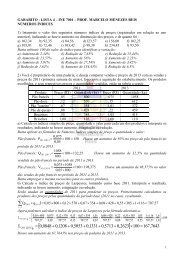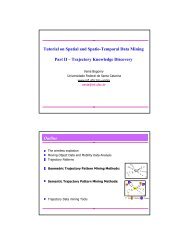Anais do IHC'2001 - Departamento de Informática e Estatística - UFSC
Anais do IHC'2001 - Departamento de Informática e Estatística - UFSC
Anais do IHC'2001 - Departamento de Informática e Estatística - UFSC
Create successful ePaper yourself
Turn your PDF publications into a flip-book with our unique Google optimized e-Paper software.
<strong>Anais</strong> <strong>do</strong> IHC’2001 - IV Workshop sobre Fatores Humanos em Sistemas Computacionais 45<br />
always able to provi<strong>de</strong> contextual information about the current topic of discourse. The<br />
persistence of information requires no effort of recall on the part of users.<br />
We have noticed that conversation on the web is less focused. It is up to the user to<br />
select and restrict the focus of conversation from a wi<strong>de</strong> range of possibilities. On the<br />
phone, however, the sequential nature of the channel has to been taken into account, and a<br />
more focused discourse took place.<br />
Moreover, the web makes it possible to carry out multiple conversations in parallel,<br />
which is not possible on the other systems. Natural discourse itself has a sequential nature<br />
and <strong>do</strong>es not allow for such parallelism. Instead, it provi<strong>de</strong>s means for switching back and<br />
forth between conversation themes and topics. On the web, however, this is not necessarily<br />
so. The user may open several different win<strong>do</strong>ws and carry out a number of in<strong>de</strong>pen<strong>de</strong>nt<br />
conversations almost simultaneously, which may cause confusion and frustration to users.<br />
We may then consi<strong>de</strong>r that the phone system is linear, whereas the ATM is bi-dimensional,<br />
and the web system is n-dimensional (Figure 5). In or<strong>de</strong>r to avoid the un<strong>de</strong>sirable si<strong>de</strong><br />
effects of the n-dimensionality of web technology, <strong>de</strong>velopers may explicitly constrain the<br />
application.<br />
dimension<br />
n-dimensional<br />
bi-dimensional<br />
linear<br />
X<br />
phone ATM web<br />
X<br />
X<br />
environment<br />
Figure 5: Conversation dimensions in different environments.<br />
When it comes to references, users of a phone-banking system have not only to keep in<br />
mind the theme and topic of conversation, but also explicitly state that they want to “go<br />
back” to a previous topic.<br />
In natural conversation, the whole range of recently referenced topics can be accessed<br />
at any time. In computational systems, however, users need access mechanisms for this. Due<br />
to the sequential nature of conversation in phone-banking systems, users may only traverse<br />
these access structures one step in each direction: 1) choose a topic of conversation or further<br />
constrain a topic; or 2) go back to a higher level in the structure, to a previous topic. Moreover,<br />
sometimes it takes quite a few exchanges in or<strong>de</strong>r to complete the selection of the topic, i.e.,<br />
the sentence generation follows a compositional approach. In this case, the access structure<br />
may be too <strong>de</strong>ep, and users may be caught in intermediary steps, with a yet-un<strong>de</strong>fined topic,<br />
and no present indication of what he/she has accomplished up to that point. The ATM follows<br />
this access structure closely, but the options available at one time are usually all displayed<br />
simultaneously on a “page”. (Sometimes users must navigate through a couple of “pages” due<br />
to a large number of options). Depending on the amount of display space, the number of<br />
options presented at a time can be significantly large, and thus we may avoid too <strong>de</strong>ep access<br />
structures. On the web, on the other hand, display space <strong>do</strong>es not pose a consi<strong>de</strong>rable



